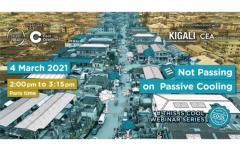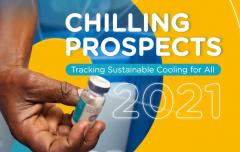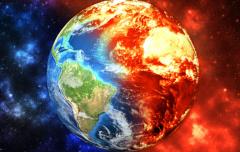Latest IPCC report highlights urgent need for sustainable cooling
On 28 February 2022, the Intergovernmental Panel on Climate Change released a report on the impacts of climate change, adaptation, and vulnerability.
The report offers one of the most detailed assessments of the threat to humans and ecosystems caused by climate change. It also serves as a stark reminder on the urgency to accelerate progress on delivering sustainable cooling for all to protect people from global warming.
The report highlights several risks posed by rising temperatures, including:
- Climate change will increase the number of people exposed to heatwaves, posing significant risks for vulnerable groups. Between 2°C and 3°C of warming, 16 times as many people would be exposed to heatwaves, rising to 36 times as many people at 4°C, causing severe risk of heat-related mortality.
- The number of work hours lost due to heat has increased significantly in the last 20 years, with some regions already experiencing heat stress that approaches the limits of labour productivity.
- The risks of heat extremes are amplified in cities. While cities can provide many benefits that reduce vulnerability, risks are aggravated by air pollution and limited key infrastructure services such as public transport and life-saving energy. The effects are concentrated among the urban poor, who may have limited or unreliable access to electricity, less access to green spaces, and live in informal settlements.
- Climate change and temperature extremes pose risks to the evolutionary tolerance of livestock and crops in rural areas. For poor rural farmers, threats to such livelihood assets could force them into persistent poverty traps.
These findings are a clear indication that global warming will hit developing countries the hardest. Regions likes Sub-Saharan Africa, South and Southeast Asia, and Latin America are most likely to experience extreme heat in the coming years, while being home to the largest proportion of urban and rural populations without access to cooling solutions needed to keep people, food and medicines safe.
As the IPCC report indicates, in Africa, the risks posed by extreme heat will have severe costs for economic development and lives lost:
- Accounting for current pledges to combat climate change, children born in Africa in 2020 are likely to be exposed to 5–10 times more heat waves compared to those born in 1960.
- African children and the elderly will be most exposed. Should global warming increase by 1.8℃, the number of Africans below age 5 and over 64 exposed to heat waves will increase from 27 million in 2010 to 360 million in 2100.
- At 1.6°C of global warming, West Africa will see between 50 and 150 days annually where potentially lethal heat thresholds are reached.
In Asia, the urban poor will suffer the most from extreme heat, and temperatures could push the boundaries of survivability across South Asia:
- The IPCC noted that the occurrence of extreme heat is very likely to increase across the region. Under a scenario of 4℃ of global warming in 2100, daily maximum wet-bulb temperatures are expected to exceed the limits of human survivability across most of South Asia.
- By 2080, between 940 million and 1.1 billion urban dwellers in South and South East Asia could experience extreme heat that lasts more than 30 days a year. It will be the urban poor, with fewer financial resources, less access to green spaces, and lower quality housing, that will suffer the most.
- At 1.5°C of global warming, on average, Kolkata, India will experience, heat equivalent to the 2015 record heat waves every year. At 2°C of global warming Karachi, Pakistan will experience the same annual heat events.
In Latin America, rising temperatures will exacerbate effects of heat stress on human comfort and health, especially in the poorest and most densely populated urban areas.
- In Central and South America heat stress is already a concern. Most countries have already experienced between 0.8 and 15.2 additional days of exposure to heatwaves in 2016-2020 compared to the past.
- Heat extremes are set to increase in frequency, intensity, and duration. With global warming of 2°C, the longest annual heatwave will last for more than 60 days longer compared to a 1.5°C scenario.
- Urbanization in the region is the second highest in the world, and growing fast, with more than 20 percent of the urban population living in slums. Those living in poor informal housing conditions have high exposure to heat island effect and low access to sanitation, public health, and residential cooling.
These findings paint a scary picture of the future, and actions taken during this decade will be decisive. And with efforts to mitigate climate change falling short of what the Paris Agreement targeted, climate change adaptation will be essential for coping with the risks and avoiding the worst adverse impacts.
Cooling is not just a luxury, it is a necessity for counteracting the devastating consequences of rising temperatures. SEforALL and its partners having been shining a light on this critical need for several years through various efforts, including our Cooling for All programme and the This Is Cool campaign.
Many of the conclusions of the recent IPCC report are aligned with our push to deliver sustainable cooling for all. We support the report’s various calls to action related to cooling solutions and strategies, including the following:
Urban greening was identified as key adaptation strategy with co-benefits that include emissions reductions, energy savings, better health outcomes, reduced urban heat effect, and water savings. While sustainable, efficient air conditioning is an important short-term adaptation option to prevent heat-related deaths, urban greening and nature-based solutions are important tools for cities to mitigate the effects of urban heat islands and protect ecosystems and people.
Governance and policy planning: Improved collaboration and coordination to mainstream heat and health into cross-cutting policy areas, such as livelihoods, social protection, and water and sanitation policies can reduce risk from heat. The IPCC noted building efficiency standards and Heat Action Plans using cool roofs and awareness building campaigns to reduce the health impacts of extreme heat as key policy tools.
Investment and finance: Targeted investments in health and food systems are key for closing adaptation gaps. Here, cross-cutting support for access to sustainable cooling and cold chains can help improve access to safe vaccines and reduce risks of malnutrition while increasing climate resilience.
Knowledge, data, and capacity building: There is a need to strengthen adaptation capacity, particularly for vulnerable groups. In cities, this is constrained by a lack of inclusive access to knowledge and depends on coordinated responses across multiple types of infrastructure. Mapping of heat vulnerability hot spots in cities was noted as a key tool to reduce heat risk.
Fortunately, such tools and interventions are already being developed in certain places around the globe, as highlighted by our This Is Cool campaign and most recent Chilling Prospects research. The key now is for these solutions to be embraced, financed and rolled out at a global scale.




